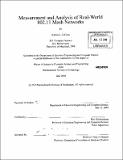Measurement and analysis of real-world 802.11 mesh networks
Author(s)
LaCurts, Katrina L. (Katrina Leigh)
DownloadFull printable version (7.018Mb)
Other Contributors
Massachusetts Institute of Technology. Dept. of Electrical Engineering and Computer Science.
Advisor
Hari Balakrishnan.
Terms of use
Metadata
Show full item recordAbstract
Despite many years of work in wireless mesh networks built using 802.11 radios, the performance and behavior of these networks in the wild is not well understood. This is primarily due to a lack of access to data from a wide range of these networks; most researchers have access to only one or two testbeds at any time. In recent years, however, these networks have been deployed commercially and have real users who use the networks in a wide range of conditions. This thesis analyzes data collected from 1407 access points in 110 different commercially deployed Meraki wireless mesh networks, constituting perhaps the largest study of real-world 802.11 mesh networks to date. After analyzing a 24-hour snapshot of data collected from these networks, we answer questions from a variety of active research topics, including the accuracy of SNR-based bit rate adaptation, the impact of opportunistic routing, and the prevalence of hidden terminals. The size and diversity of our data set allow us to analyze claims previously only made in small-scale studies. In particular, we find that the SNR of a link is a good indicator of the optimal bit rate for that link, but that one could not make an SNR-to-bit-rate look-up table that was accurate for an entire network. We also find that an ideal opportunistic routing protocol provides little to no benefit on most paths, and that "hidden triples"-network topologies that can lead to hidden terminals-are more common than suggested in previous work, and increase in proportion as the bit rate increases.
Description
Thesis (S.M.)--Massachusetts Institute of Technology, Dept. of Electrical Engineering and Computer Science, 2010. Includes bibliographical references (p. 63-65).
Date issued
2010Department
Massachusetts Institute of Technology. Department of Electrical Engineering and Computer SciencePublisher
Massachusetts Institute of Technology
Keywords
Electrical Engineering and Computer Science.